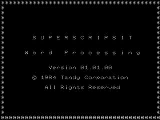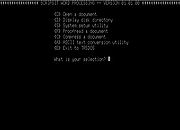
Scripsit
Encyclopedia
Scripsit is a word processing application written for the Radio Shack
TRS-80
line of computers. Versions were available for most if not all computers sold under the TRS-80 name, including the Color Computer and several pocket computer
designs, as well as the Tandy version of the Xenix
operating system. Some of these versions were tape-based and have no disk features.
Despite its limitations, it was seen at the time as a killer application
for the TRS-80 line of machines, along with other breakthrough applications such as VisiCalc
. The software market moved quickly, however, and its popularity soon gave way to WordPerfect
running on the IBM PC
.
Word processors typically require the use of special function keys to access editing commands as opposed to text entry. This proved to be a challenge on the TRS-80 Model I and Model III computers, as their keyboards had no non-typewriter modifier keys—not even a [Control] key. Instead, Tandy drafted the '@' key to access features such as margin control and load/save.
 An alternate disk-only version named Superscripsit was available with spellchecking for some platforms, specifically the Model I, Model III, and Model 4. This version basically matches the functionally of the normal Scripsit for disk-based platforms such as the Model II, Model 12, and Model 16. Some additional features such as boilerplating and integration with Profile
An alternate disk-only version named Superscripsit was available with spellchecking for some platforms, specifically the Model I, Model III, and Model 4. This version basically matches the functionally of the normal Scripsit for disk-based platforms such as the Model II, Model 12, and Model 16. Some additional features such as boilerplating and integration with Profile
, Tandy's database program for all of their TRS-80 platforms, are available for the disk versions.
Starting Superscripsit led to a main menu of tasks, where the user could choose Open, Proofread, Setup and so on. Presumably because of the limited screen area on most TRS-80 models, there were no visible menus on the editing screen. RAM was probably also an issue, since selecting each of the options resulted in heavy floppy disk activity.
Radio shack
Radio shack is a slang term for a room or structure for housing radio equipment.-History:In the early days of radio, equipment was experimental and home-built. The first radio transmitters used a noisy spark to generate radio waves and were often housed in a garage or shed. When radio was first...
TRS-80
TRS-80
TRS-80 was Tandy Corporation's desktop microcomputer model line, sold through Tandy's Radio Shack stores in the late 1970s and early 1980s. The first units, ordered unseen, were delivered in November 1977, and rolled out to the stores the third week of December. The line won popularity with...
line of computers. Versions were available for most if not all computers sold under the TRS-80 name, including the Color Computer and several pocket computer
Pocket computer
A pocket computer is a small calculator-sized handheld programmable computer.This specific category of computers existed primarily in the 1980s. Manufacturers included Casio, Hewlett-Packard, Sharp, Tandy/Radio Shack and many more.The programming language was usually BASIC, but some devices...
designs, as well as the Tandy version of the Xenix
Xenix
Xenix is a version of the Unix operating system, licensed to Microsoft from AT&T in the late 1970s. The Santa Cruz Operation later acquired exclusive rights to the software, and eventually superseded it with SCO UNIX ....
operating system. Some of these versions were tape-based and have no disk features.
Functionality
Scripsit was a rudimentary word processor. It has basic text entry and margin controls, as well as word wrap. Many versions tied to specific platforms were available, and each had its own set of features. Most versions supported variable width fonts, specifically for daisy-wheel printers. None had support for graphics other than some character macros depending on the version. The Model I version even had special handling for lowercase characters.Despite its limitations, it was seen at the time as a killer application
Killer application
A killer application , in the jargon of marketing teams, has been used to refer to any computer program that is so necessary or desirable that it proves the core value of some larger technology, such as computer hardware, gaming console, software, or an operating system...
for the TRS-80 line of machines, along with other breakthrough applications such as VisiCalc
VisiCalc
VisiCalc was the first spreadsheet program available for personal computers. It is often considered the application that turned the microcomputer from a hobby for computer enthusiasts into a serious business tool...
. The software market moved quickly, however, and its popularity soon gave way to WordPerfect
WordPerfect
WordPerfect is a word processing application, now owned by Corel.Bruce Bastian, a Brigham Young University graduate student, and BYU computer science professor Dr. Alan Ashton joined forces to design a word processing system for the city of Orem's Data General Corp. minicomputer system in 1979...
running on the IBM PC
IBM PC
The IBM Personal Computer, commonly known as the IBM PC, is the original version and progenitor of the IBM PC compatible hardware platform. It is IBM model number 5150, and was introduced on August 12, 1981...
.
Word processors typically require the use of special function keys to access editing commands as opposed to text entry. This proved to be a challenge on the TRS-80 Model I and Model III computers, as their keyboards had no non-typewriter modifier keys—not even a [Control] key. Instead, Tandy drafted the '@' key to access features such as margin control and load/save.
SuperScripsit

FilePro
filePro is a proprietary DBMS and RAD system originally developed by Howard Wolowitz as The Electric File Clerk in 1978. He licensed it to Tandy Corporation in 1979 who first published it in 1980 as Profile II....
, Tandy's database program for all of their TRS-80 platforms, are available for the disk versions.
Starting Superscripsit led to a main menu of tasks, where the user could choose Open, Proofread, Setup and so on. Presumably because of the limited screen area on most TRS-80 models, there were no visible menus on the editing screen. RAM was probably also an issue, since selecting each of the options resulted in heavy floppy disk activity.

